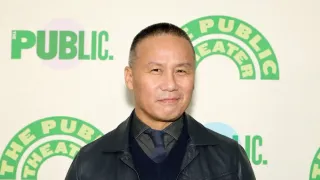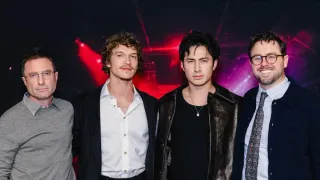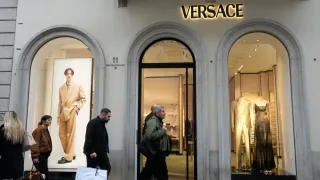July 8, 2024
Alonso Duralde Connects the Queer Dots in 'Hollywood Pride: A Celebration of LGBTQ+ Representation and Perseverance in Film'
Steve Duffy READ TIME: 11 MIN.
Recently, as part of Turner Classic Movies Pride presentation of six LGBTQ+ films, host Dave Karger spoke with film critic, author, and historian Alonso Duralde about the 1950 prison exposé "Caged," a movie he writes about in his new book, "Hollywood Pride: A Celebration of LGBTQ+ Representation and Perseverance in Film."
The lurid film has long been a queer cult classic in its depiction of the queer subculture in the prison where naïve Eleanor Parker is incarcerated, but that subculture is never directly addressed. "I think there are a history of films that have a queer subtext whether or not they address the elephant in the room," Duralde tells Karger. "And those are films that deal with gender-specific surroundings, so whether its men in a submarine or women in prison, the absence of the other gender provide often a LGBTQ+ reading."
In the case of "Caged," the women-only setting has "a sexual subcurrent....This is the period of the Code when they [filmmakers] couldn't deal directly with LGBTQ+ lives or story lines, but they [the censors] always looked the other way if it was presented as a negative or scary thing."
Queer individuals were faced with a double whammy for most of the 20th century in Hollywood: Not only weren't they able to be public about their sexuality, but they couldn't tell their own stories on screen. Yet, they found ways, not necessarily able to come out (witness Rock Hudson), but to inform films, such as "Caged," "Laura," and "Rope" (amongst others) with coded subtexts that some in the audience picked up on.
Duralde follows those threads, and examines how queers in Hollywood have evolved in a deeply homophobic industry. From the silent era, when actress Nazimova coined the phrase "sewing circle" to refer to closeted female actors, to subsequent Hollywood eras, Duralde examines the ways in which queer artists found ways to express themselves. He includes such pioneers like William Haines, who quit acting because he wouldn't deny being gay, and George Cukor, who built strong relationships with such stars as Joan Crawford and Katherine Hepburn during his long career while famously hosting gay pool parties at his Beverly Hills home. He looks at how fear of exposure affected the careers of such stars as Hudson and Greta Garbo, and examines how the breakup of the studio system led to a more open climate, represented by the work of such underground directors as John Waters and Kenneth Anger.
Illustrated with more than 175 full-color and black-and-white images, "Hollywood Pride" looks back at LGBTQ+ representation in Hollywood filmmaking by revealing the story of the community's inclusion and erasure, its visibility and invisibility, and its triumphs and tragedies.
Author Duralde, who has been a film critic and editor, wrote "101 Must-See Movies for Gay Men" (Advocate Books), as well as a book about Christmas in the movies ("Have Yourself a Movie Little Christmas" [Limelight Editions]). As a film critic, he has reviewed for The Wrap/Reuters, and has written about film for Movieline, Salon, MSNBC.com, and HitFix, among many other publications. He also co-hosts the Linoleum Knife podcast and regularly appears on "What the Flick?!"(on The Young Turks Network). He also serves as Senior Programmer for the Outfest Film Festival in Los Angeles and as a pre-screener for the Sundance Film Festival; he is also a consultant for the USA Film Festival/Dallas, where he spent five years as Artistic Director.
A former Arts and Entertainment Editor at The Advocate, Duralde was a regular contributor to "The Rotten Tomatoes Show" (on Current) and has been seen in more than 30 documentaries and television series, including "Queer for Fear: The History of Queer Horror," "50 Documentaries to See Before You Die," and "Fabulous! The Story of Queer Cinema," as well as on the special features of the "Brokeback Mountain" and "Valley of the Dolls" DVDs.
EDGE spoke to Duralde about "Hollywood Pride," his life as film critic and historian, and what a non-queer person would get from his book.
EDGE: Tell us about your love of films and when it started.
Alonso Duralde: I often relate it to [this]: Did you ever see that movie "Searching for Bobby Fisher," where the little kid sees chess being played for the first time and comes home and re-creates a chessboard in his room? I was obsessed with movies before I was even going to the movies. I learned to read partially by combing the film listings in the Atlanta Journal-Constitution every day. I could tell you what was playing at any theater near our house, even though I wasn't going to the movies, but I was fixated on it. It's been a lifelong passion. When I was about nine, my brother came home from college with all of these books about the Golden Age of Hollywood, and I just devoured them. I've been on this path ever since.
EDGE: What inspired the idea for your book?
Alonso Duralde: It was pitched to me, actually, which I thought was a cool idea. TCM and Running Press had previously done two books focusing on specific avenues of film history. They published "Hollywood Black" in 2022, and then "Viva Hollywood," which focuses on Latina artists and films coming out of the studio system. My editor, Randall Litz, came up with the idea of publishing a queer one.
EDGE: Is there an era of film that fascinates you the most?
Alonso Duralde: There was a learning curve for me in terms of early cinema, especially digging into who were the queer artists and what sort of glimmers of queer visibility were there. That was probably what I knew the least about, going into this. I'm old enough that I was witness to the new queer cinema because I was working at a film festival in the early nineties, and I knew that was going on, and I met a lot of the filmmakers at the time. I do have a smattering of knowledge about the silent era and early talkies, but to delve into it from an LGBTQ+ angle brought me to places I was not familiar with.






